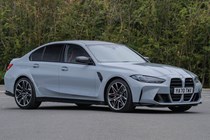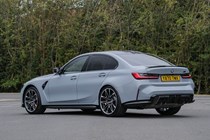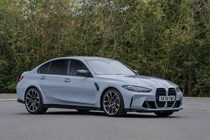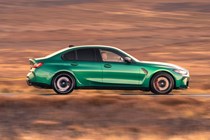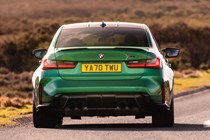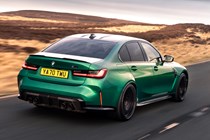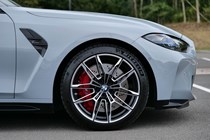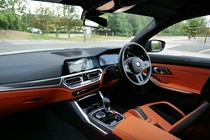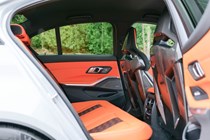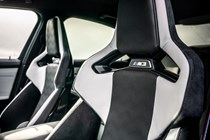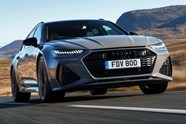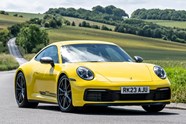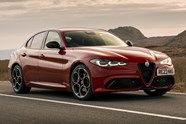
BMW 3-Series M3 review

At a glance
| Price new | £89,545 - £97,370 |
|---|---|
| Used prices | £37,839 - £104,754 |
| Road tax cost | £620 |
| Insurance group | 41 - 49 |
Get an insurance quote with

|
|
| Fuel economy | 27.4 - 28.8 mpg |
| Miles per pound | 4.0 - 4.2 |
| Number of doors | 4 |
| View full specs for a specific version | |
Available fuel types
Petrol
Pros & cons
- Brilliant to drive
- Fairly practical
- Compelling engine
- Very expensive BMW 3 Series
- Controversial styling
- Aurally not exciting
BMW 3-Series M3 rivals
Overview
The BMW M3 is the hardest, fastest and most expensive version of the BMW 3 Series saloon. It’s an extreme super saloon – the least powerful model you can buy in the UK has 510hp, a 0–62mph of 3.9 seconds and an electronically limited top speed of 155mph. That means this family saloon is quick enough to keep pace with a Porsche 911.
But BMW didn’t stop there. It obviously felt the standard M3 wasn’t scary enough, so they gave it an extra 40hp, stripped 20kg out of its chassis and fitted it with some track-ready suspension to create the M3 CS. The upgrades slash the saloon’s 0–62mph time down to 3.4 seconds and increase its top speed to 188mph. That was supercar territory just 20 years ago.
The M3’s favourite sparring partner has long been the Mercedes-AMG C 63. But the two cars aren’t boxing on an even keel now. Mercedes completely changed the car’s character by chopping its signature V8 in for a 680hp 2.0-litre four-cylinder plug-in hybrid powertrain.
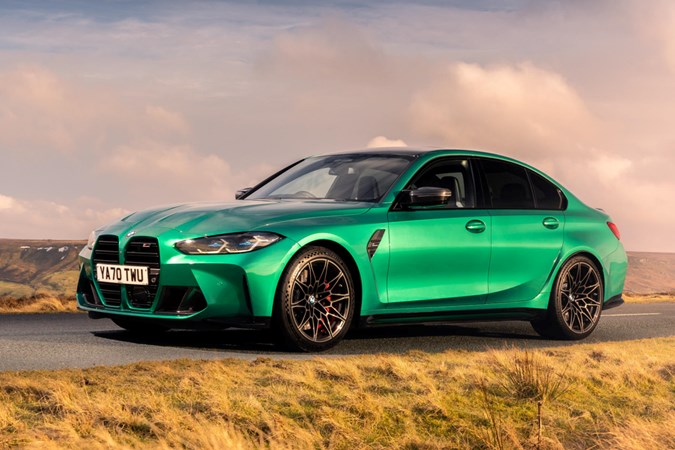
It’s undeniably a fast car, but it might not appeal to petrolheads in the same way as the pure-combustion powered BMW (which is kind of the point). For that reason, if the M3 doesn’t tickle your fancy, we’d sooner direct you towards the similarly flawed but utterly fabulous Alfa Romeo Giulia Quadrifoglio.
Scroll down to read our complete review of the BMW M3. Full disclaimer – it really is an excellent bit of kit, assuming you walk into ownership with your eyes wide open. Not only is it the most expensive 3 Series you can buy (by an enormous margin), but it’s also the least fuel efficient and most uncomfortable. So, make sure you’re happy making those sacrifices before signing your name on the V5C.
What’s it like inside?
Much the same as the standard M3. Just with added sportiness. The seats are the biggest talking point here. The standard chairs are more supportive than you get in the 3 Series – but, if you’re serious about driving, you can spend a bit more money on a set of optional carbon fibre-backed sports seats.
They’re super hard, body-hugging affairs with a prominent beam between the driver’s legs – and they’re supposed to mimic racing seats with three-point harnesses. They’re quite comfortable once you’ve folded yourself into them but, because they have such heavy bolsters, getting seated can be difficult to do elegantly.
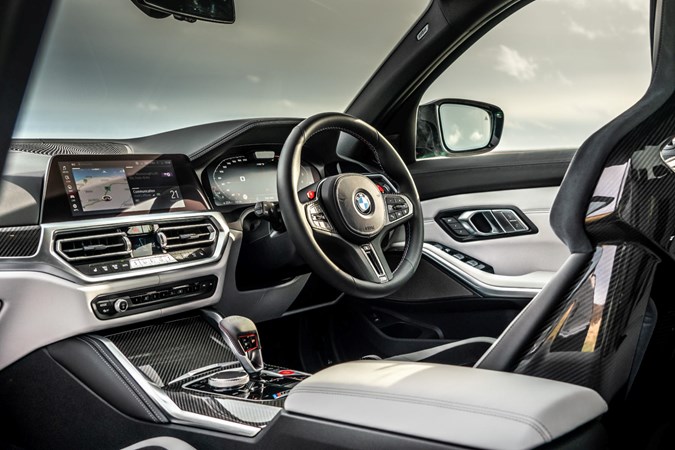
BMW kept the rest of the M3’s cockpit the same as the standard 3 Series. This is a good thing because it means you get BMW’s excellent iDrive infotainment system that allows you to navigate the screen using touch commands or a rotary controller on the centre console. The latter option is far easier to operate on the move, especially in car with suspension as stiff as this. You crash around a lot on a bumpy B-road.
Rear seating isn’t too bad, either. The bench is quite solid but there’s room for an extra two adults assuming your passengers don’t mind the hard ride. And even though the M3 is primarily a performance car, it retains a lot of the practicality of the regular 3 Series. Interior storage is the same between the two cars and, at 480 litres the boot is on par with the standard saloon, meaning you can use it as an everyday car.
What’s it like to drive?
The latest M3 is the first to be fitted with four-wheel drive. Purists lamented this change, but the truth is, most of the time, the M3 still feel rear-biased. It still drives sweetly and neutrally – you’ll only really notice the front wheels clawing at the Tarmac when you’re driving like an absolute idiot.
The steering is very fast. You hardly need more than a quarter turn from the centre to round most corners on your average B-road. It’s surgically precise. The sensation is dialled up even further for the range-topping CS model, but that makes the car feel a little too nervous, especially when you’re cruising down the motorway.
It’s not far short of perfect on a twisty road, though. BMW has tuned the M3’s suspension well enough to mask the car’s substantial 1,805kg weight. The front end bites into the corner admirably for a car this heavy, while the rear end stays pinned to the road unless you turn the traction control off, thanks in equal measure to good chassis engineering and clever driver assistance technology.

BMW’s twin-turbo 3.0-litre six-cylinder engine is ferocious. It certainly isn’t the best-sounding engine in its class. It sounds a bit tinny in the mid-range if we’re being brutally honest. But it revs sweetly from 2,500rpm right up to its redline and it seems to have a bottomless well of power. No one will feel like it’s lacking in that department.
But that didn’t stop BMW from turning up the wick. The M3 CS is a different beast. It has the same 650Nm of torque (pulling power) as the standard M3, but it produces 550hp. That means it has a bit more poke in the upper echelons of its rev-range.
It delivers its power differently, too. It’s far less linear than the standard M3. Acceleration is quite underwhelming until you hit about 3,000rpm, at which point the turbos wake up, cram all their boost into the engine and fire you at the horizon like an Exocet missile. It’s a riot.
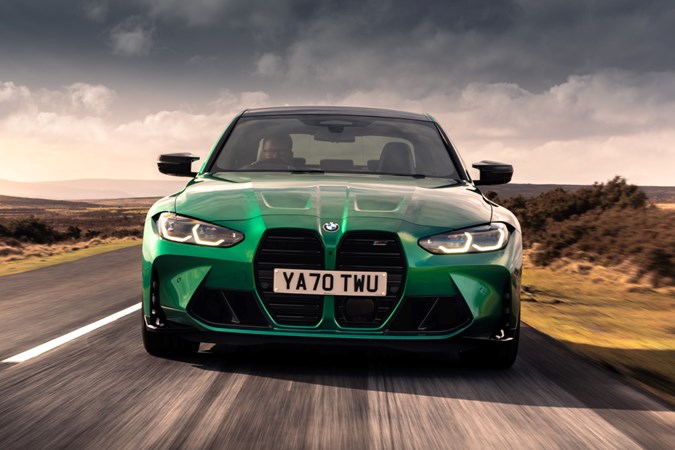
The engine is mated to an eight-speed automatic gearbox and, although it isn’t a clever dual-clutch unit like you’ll find in the Porsche Panamera, its shifts are incredibly fast and ferocious enough to match the anger of the engine. You can also adjust the severity of the changes, which means you wind it down when you just want to be comfortable.
Speaking of comfort, it should go without saying that the M3 is much less compliant than a regular 3 Series. Both the standard M3 and the CS are fitted with adjustable dampers which, even in their softest setting are noticeably harsher. Put the cars in their sportiest settings and you’ll find that bumpy roads will thrash you around the cabin like a ragdoll.
What models and trims are available?
The UK M3 range used to be simple, but BMW has complicated it. There are two main specifications to choose from – the standard M3 Competition and the track-ready M3 CS. Both are fitted with four-wheel drive as standard, but the CS has a little more power and a more aggressive suspension and braking setup.
In summer 2022, BMW launched its first ever M3 Touring. It shares its body shell with the 3 Series estate, but it features the same mechanical setup as the M3 saloon. It’s a stunningly competent family wagon that walks all over the Audi RS4 Avant with its superior cornering ability and supercar-baiting acceleration.
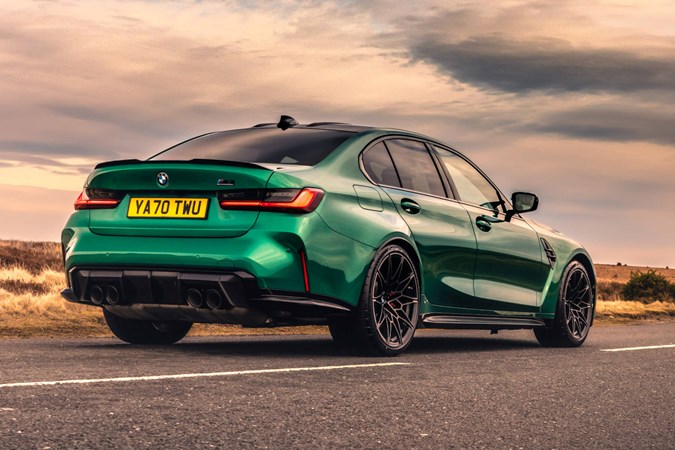
Naturally, because this is BMW, there’s any number of option packs for buyers to customise their cars with. The biggest one is the Ultimate Pack. This comprises four out of the five packs available and includes extras such as carbon fibre exterior styling, semi-autonomous driving tech, keyless entry, a heated steering wheel and carbon bucket seats.
Now read our verdict page to find out whether the BMW M3 is worth spending your money on, or whether you should opt for one of its rivals instead.


